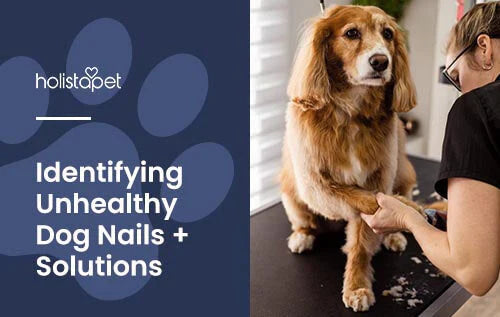Your pup's nails tell a story about their overall health. Therefore, decoding the signs of unhealthy dog nails is important to keep them happy and healthy. If left untreated, these red flags can turn into full-blown health issues.
In this article, you'll get a crash course on dog nail health. Understand the causes and symptoms of unhealthy nails in your canine companion. Plus, get answers to your frequently asked questions. From common nail disorders to proper nail care, we have some valuable insights for you.
Importance of a Dog's Nail Health
A dog's nail health impacts not just their mobility but their well-being, too. Healthy nail growth and proper nail care can help prevent issues like nail fractures, ingrown nails, and fungal nail infections. With healthy nails, your furry friend can walk comfortably and feel great overall.
Regular nail clipping and monitoring your dog's nail condition can save both of you from long-term problems. Remember, when your furry friend's nails are in tip-top shape, they can stay active and ready for all of life's adventures.
Common Dog Nail Problems
Dog nail problems can range from minor annoyances to serious health conditions. Spotting these common issues early can help prevent complications:
- Ingrown Nails
- Nail Fractures
- Nail Bed Infections
- Trimming Accidents
In the succeeding sections, we'll discuss these common dog nail troubles in more detail. Let's go ahead and break down their causes, symptoms, and solutions.
Ingrown Nails
When a dog's nail grows into surrounding skin tissue, it can lead to discomfort and infection. This ingrown condition often happens when a pup's nails are not regularly or properly trimmed. Pets with ingrown claws may start limping to signal discomfort. You may also observe excessive licking of the affected paw.
To treat ingrown dog claws, carefully trim the nails to prevent further growth into the skin. In severe cases, you'll need to visit your vet for expert help.
Nail Fractures
Trauma or pressure on the nails can cause nail fractures. For example, running on hard surfaces or catching the nail on something can cause it to crack or break. A fractured nail can be very uncomfortable and, if ignored, may lead to infection.
Clean the affected nail gently and put a bandage on it for immediate remedy. In severe cases, your vet may need to trim the damaged part of the nail and prescribe antibiotics to prevent bacterial infections.
Nail Bed Infections
Infections on a dog's nail beds happen when bacteria or fungi invade the sensitive tissue around the nails. Such dog nail infections can cause redness, swelling, and soreness. Pups with nail bed infections may lick or chew their affected paw excessively, indicating discomfort.
Clean the area with a gentle antiseptic to treat a nail bed infection. Also, consult your vet for appropriate medication.
Trimming Accidents
When you cut your dog's nails too short, they can bleed and feel great discomfort. Bleeding happens when the quick, a blood vessel inside the nail, is accidentally clipped.
If you accidentally cut your dog's quick, apply styptic powder or cornstarch to help stop the bleeding. Comfort your friend and give them treats to help ease their fear. Use proper dog nail clippers and trim small amounts of the nail at a time to prevent future accidents.

Common Causes of Dog Nail Disorders
Nail disorders in dogs can arise from various factors. Understanding these causes can help prevent and manage nail problems effectively:
- Lack of Regular Nail Trimming
- Lack of Proper Nutrition
- Nail Trauma
- Nail Infections
- Underlying Health Conditions
- Genetic Factors
In the following sections, we'll discuss these specific causes of dog nail disorders in more detail. We'll also provide more insights into maintaining healthy dog nails.
Lack of Regular Nail Trimming
Overgrown nails are more likely to break, split, or become ingrown. Long nails can also affect a dog's mobility and lead to joint issues over time. Regular nail cutting helps prevent these problems. Aim to trim your dog's nails every few weeks. If you need help with how to do this, we have a step-by-step guide for you later.
Lack of Proper Nutrition
A balanced diet rich in essential nutrients supports healthy dog nails. When pups lack important vitamins and minerals, they can develop brittle and weak nails. So, make sure your pet's diet has enough protein, vitamins, and minerals to help boost their nail health.
Nail Trauma
Running on rough surfaces, getting nails caught in objects, or even intense play can cause nail damage. Such trauma can lead to discomfort, bleeding, and even bacterial nail infections. To prevent these, make sure your furry buddy's play area is safe. Regular nail clipping can also help reduce the risk of nail damage.
Nail Infections
Infections can result from bacteria, fungi, or yeast entering a dog's nail bed or surrounding skin. Symptoms often include redness, swelling, and a foul odor. Dogs with bacterial, yeast, or fungal infections may lick or chew their paws excessively. Treatment typically involves cleaning the infected nails and applying vet-prescribed topical medications.
Underlying Health Conditions
Underlying health conditions like hypothyroidism, autoimmune diseases, and allergies can lead to brittle and weak nails prone to infections. These health issues require veterinary diagnosis and treatment. So, regular veterinary checkups are key here. Managing these conditions with appropriate treatments and medications can help improve your pup's nail health and overall well-being.
Genetic Factors
Did you know that certain dog breeds are more prone to nail disorders due to their genetic makeup? For example, breeds like Greyhounds, Dalmatians, and Boxers may experience nail issues more frequently than others. So, understanding your dog's breed-specific nail care needs can help prevent problems down the line.
Unhealthy Dog Nails - Symptoms
Recognizing the signs of unhealthy dog nails is the first step toward prevention and treatment. Here are some symptoms to watch out for:
- Brittle Nails. Nails that break or crack easily.
- Broken Nails. Nails that have snapped or fractured.
- Discolored Nails. Nails that appear yellow, brown, or black.
- Overgrown Nails. Nails that are excessively long and may curl.
- Ingrown Nails. Nails growing into the surrounding skin tissue.
- Misshapen Nails. Nails that have an abnormal shape.
- Thickened Nails. Nails that appear unusually thick.
- Limping. Difficulty walking or favoring one paw.
- Excessive Licking. Constant licking or chewing of paws.
- Bleeding or Discharge. Presence of blood or fluid around the nails.
- Foul Odor and Swelling. Unpleasant smell and noticeable swelling around the nails.
How To Prevent or Treat Unhealthy Dog Nails
Preventing and treating unhealthy dog nails involves consistent care and attention. Maintaining your pup's nail condition can help with their comfort level and mobility. Here are a few things to keep in mind:
- Regular Nail Trimming and Grooming
- Regular Exercise
- Balanced and Nutritious Diet
- Protecting the Paw Pads
- Skin, Coat, and Nail Supplements
- Regular Vet Checkups
Following proper nail care practices can potentially prevent most nail-related issues. The next sections will provide more detailed methods to keep your dog's nails healthy and strong.
Regular Nail Trimming and Grooming
Overgrown nails can lead to discomfort, ingrown nails, and other complications. Keeping your dog's nails trimmed appropriately can help prevent these issues. Regular grooming sessions can also let your professional groomer inspect your dog's paws for any signs of nail problems.
Regular Exercise
Walking on various surfaces like grass, sand, and pavement can keep your dog's nails at an optimal length. Keep your pup busy with daily activities, such as walks, playtime, and interactive games. These exercises not only keep their nails healthy but also promote overall well-being.
Related Post: How Much Exercise Do Dogs Need
Balanced and Nutritious Diet
Make sure your dog has a proper diet that includes essential nutrients like proteins, vitamins, and minerals. Consult your vet to determine the best diet for your dog, considering their age, breed, and health needs. Pair high-quality dog food with supplements, if necessary.
Related: Holistapet Supplements for Dogs
Protecting the Paw Pads
Harsh surfaces, extreme temperatures, and rough terrain can damage your dog's paw pads and nails. Use dog paw balm or booties to shield your dog's paws during walks. Regularly inspect your dog's paws for any signs of injury or wear and tear. Also, keeping the paw pads moisturized and clean can help prevent cracks and infections.
Skin, Coat, and Nail Supplements
Products like HolistaPet's Skin, Coat, and Nail Soft Chews for Dogs contain beneficial ingredients that promote strong and healthy nails. Our bestselling soft-baked chews contain fish oil, aloe vera, ascorbic acid (vitamin C), and biotin for glowing skin, smooth coat, and healthy nails. Incorporating these chews into your dog's diet may help keep those pesky nail problems at bay. Remember to consult your vet before starting your dog on any new supplements.
Regular Vet Checkups
No one can better detect the early signs of nail disorders than a vet. They can recommend appropriate treatments and preventative measures. They can also advise on nail care techniques and suggest suitable products. Plus, they can check for underlying health conditions that might affect your dog's nails.

How To Trim Your Dog's Nails - A Step-By-Step Guide
Trimming your dog's nails at home can be simple and fuss-free with the right approach. Here's a clear and simple guide:
- Choose the Perfect Spot. Find a quiet and comfortable area where your dog feels relaxed.
- Prepare Your Tools. Gather high-quality nail clippers, styptic powder, and treats.
- Let Your Dog Sniff and Inspect. Allow your dog to get familiar with the tools to reduce their worries.
- Hold Your Dog's Paw Firmly but Gently. Ensure a secure grip without causing discomfort.
- Start Clipping Carefully. Trim small portions of the nail, avoiding the quick.
- Reward Your Dog. Give treats and praise to create a positive experience.
- Make It a Habit. Regular trimming sessions help maintain good nail condition and reduce troubles for you and your dog.
Dog Nails - Frequently Asked Questions
Dog nail care often raises several questions among pet owners. Understanding the basics can help you maintain your dog's nail health effectively. The following sections will answer some of the most common questions about dog nails. Read on to get some clear and concise information.
How Often Should I Trim My Dog's Nails?
You should trim your dog's nails every 3-4 weeks, depending on their growth rate and activity level. Active dogs may naturally wear down their nails, requiring less frequent trims. Less active dogs might need more regular attention. Monitor your dog's nails and adjust the trimming schedule as needed. If you hear your dog's nails clicking on hard surfaces, it's time for a trim.
What Are the Signs of Healthy Dog Nails?
Healthy dog nails are strong, smooth, and free of cracks or splits. They should also not cause your dog discomfort. Signs of healthy dog nails include:
- Clear or Uniform Color. Nails that have a consistent color, typically light or clear.
- Appropriate Length: Nails that do not touch the ground or curve inward excessively.
- No Odor or Discharge. Nails that are free from foul smells or any discharge.
- Smooth Texture. The surface of the nails should be smooth without rough edges.
What Should I Do if I Accidentally Cut My Dog's Nail Quick?
If you accidentally cut your dog's nail quick, apply styptic powder or cornstarch to help stop the bleeding. Hold a clean cloth or gauze against the nail to apply gentle pressure until the bleeding slows down. Comfort your dog and offer a treat to help reduce their fears. Keep an eye on the nail over the next few days. If the bleeding doesn't stop or the nail looks infected, consult your vet for help.
Can I Get Someone Else To Trim My Dog's Nails?
Yes, you can get someone else to trim your dog's nails. Professional groomers and veterinarians offer nail grooming services and have the experience to handle the task safely. Taking your dog to a professional can help reduce the risk of accidents. Plus, they can provide tips if you want to trim your dog's nails at home in the future.
Unhealthy Dog Nails - A Recap
Unhealthy dog nails can cause your pup great discomfort and lead to serious health issues if not treated properly. Regular nail trimming, a balanced diet, proper exercise, paw pad protection, helpful supplements like ours, and regular vet checkups are essential for maintaining healthy dog nails.
Following the tips and tricks in this guide can help keep your dog's nails healthy and strong. With healthy nails, you can ensure a happy and active life for your furry friend!







![Probiotics For Dogs [Soft Chews] - HolistaPet](http://www.holistapet.com/cdn/shop/files/Probiotic-Infographic-1_472d7a29-e30c-435a-9638-1365d8c3a9f9.jpg?v=1725384841&width=104)



























Leave a comment
All comments are moderated before being published.
This site is protected by hCaptcha and the hCaptcha Privacy Policy and Terms of Service apply.